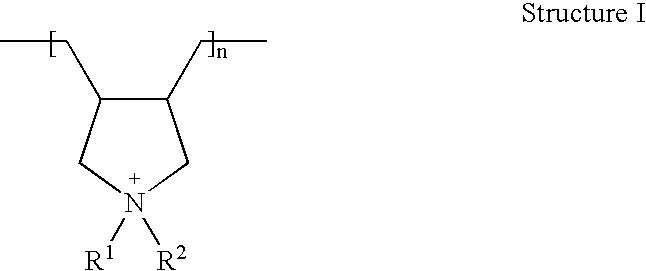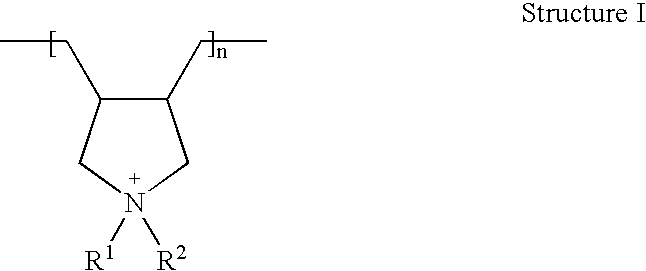Water-Absorbing Polymer Structure Surface-Treated with Polycations
a polycation and polymer technology, applied in the field of water-absorbing polymer structure, can solve the problems of unsatisfactory absorption behavior and unsatisfactory absorption behavior of absorbent structures which comprise these polymers in high concentrations
- Summary
- Abstract
- Description
- Claims
- Application Information
AI Technical Summary
Benefits of technology
Problems solved by technology
Method used
Image
Examples
examples
1. Preparation of SAP Particles (Degree of Neutralization 50 Mol %)
[0166]A monomer solution consisting of 300 g acrylic acid, 166.52 g 50% sodium hydroxide solution, 497.12 g deionized water, 1.176 g monoallylpolyethyleneglycol-450-monoacrylic acid ester, 0.988 g polyethyleneglycol-300-diacrylate and 6.13 g polyethylene glycol-750-monomethacrylic acid ester methyl ether was flushed with nitrogen to remove dissolved oxygen and cooled to the start temperature of 4° C. After reaching the start temperature, the initiator solution (0.3 g sodium peroxydisulfate in 9.7 g H2O, 0.07 g 35.5% hydrogen peroxide solution in 1.93 g H2O and 0.015 g ascorbic acid in 4.99 g H2O) was added. After the end temperature of about 100° C. was reached, the resulting gel was comminuted and dried at 150° C. for 120 minutes. The dried polymer was coarsely ground, milled, and sieved to a powder with a particle size from 150 to 850 μm (=powder A).
2. Preparation of SAP Particles (Degree of Neutralisation 70 Mol %...
examples 1 and 2
SAP-Polymer with 70 Mol % Degree of Neutralization
[0168]The powder B was combined with a solution comprising the amounts of water, ethylene carbonate as post-crosslinker and polydiallyldimethylammonium chloride (MW=450,000 g / mol) in the amounts given in the following table with vigorous stirring and then heated for the amount of time given in table 1 at the temperatures likewise given in table 1 (the amounts given of water, ethylene carbonate and polydiallyldimethylammonium chloride are respectively the amounts in grams, based on 100 grams of powder B).
TABLE 1PolydiallyldimethylammoniumchlorideEthylene(as 30% solution inTimeTemperatureExampleWatercarbonateH2O)[minutes][° C.]1 (not2.51075190inventive)201375190(inventive)
[0169]The absorption properties of the polymer obtained in Examples 1 and 2 are given in the following table 2:
TABLE 2Polymer fromWicking IndexSFC value [cm3example[cm]sg−1]Retention [g / g]15.512722.527.519922.7
examples 3 and 4
SAP Polymer with 50 Mol % Degree of Neutralization
[0170]The powder A was combined with a solution comprising the amounts given in the following table 3 of water, ethylene carbonate as post-crosslinker, and polydiallyldimethylammonium chloride (MW=450,000 g / mol) with vigorous stirring and then heated for the amount of time given in table 3 at the temperatures likewise given in table 3 (the amounts given of water, ethylene carbonate, and polydiallyldimethylammonium chloride are respectively the amounts in grams, based on 100 g of powder A):
TABLE 3PolydiallyldimethylammoniumchlorideEthylene(as 30% solution inTimeTemperatureExampleWatercarbonateH2O)[minutes][° C.]3 (not2.51030180inventive)401330180(inventive)
[0171]The absorbent properties of the polymers obtained in examples 3 and 4 are detailed in the following table 4:
TABLE 4Polymer fromWickingSFC valueRetentionexampleIndex [cm][cm3 sg−1]AAP [g / g][g / g]37.015119.521.9410.524920.320.9
PUM
| Property | Measurement | Unit |
|---|---|---|
| Length | aaaaa | aaaaa |
| Time | aaaaa | aaaaa |
| Dimensionless property | aaaaa | aaaaa |
Abstract
Description
Claims
Application Information
 Login to View More
Login to View More - R&D
- Intellectual Property
- Life Sciences
- Materials
- Tech Scout
- Unparalleled Data Quality
- Higher Quality Content
- 60% Fewer Hallucinations
Browse by: Latest US Patents, China's latest patents, Technical Efficacy Thesaurus, Application Domain, Technology Topic, Popular Technical Reports.
© 2025 PatSnap. All rights reserved.Legal|Privacy policy|Modern Slavery Act Transparency Statement|Sitemap|About US| Contact US: help@patsnap.com



